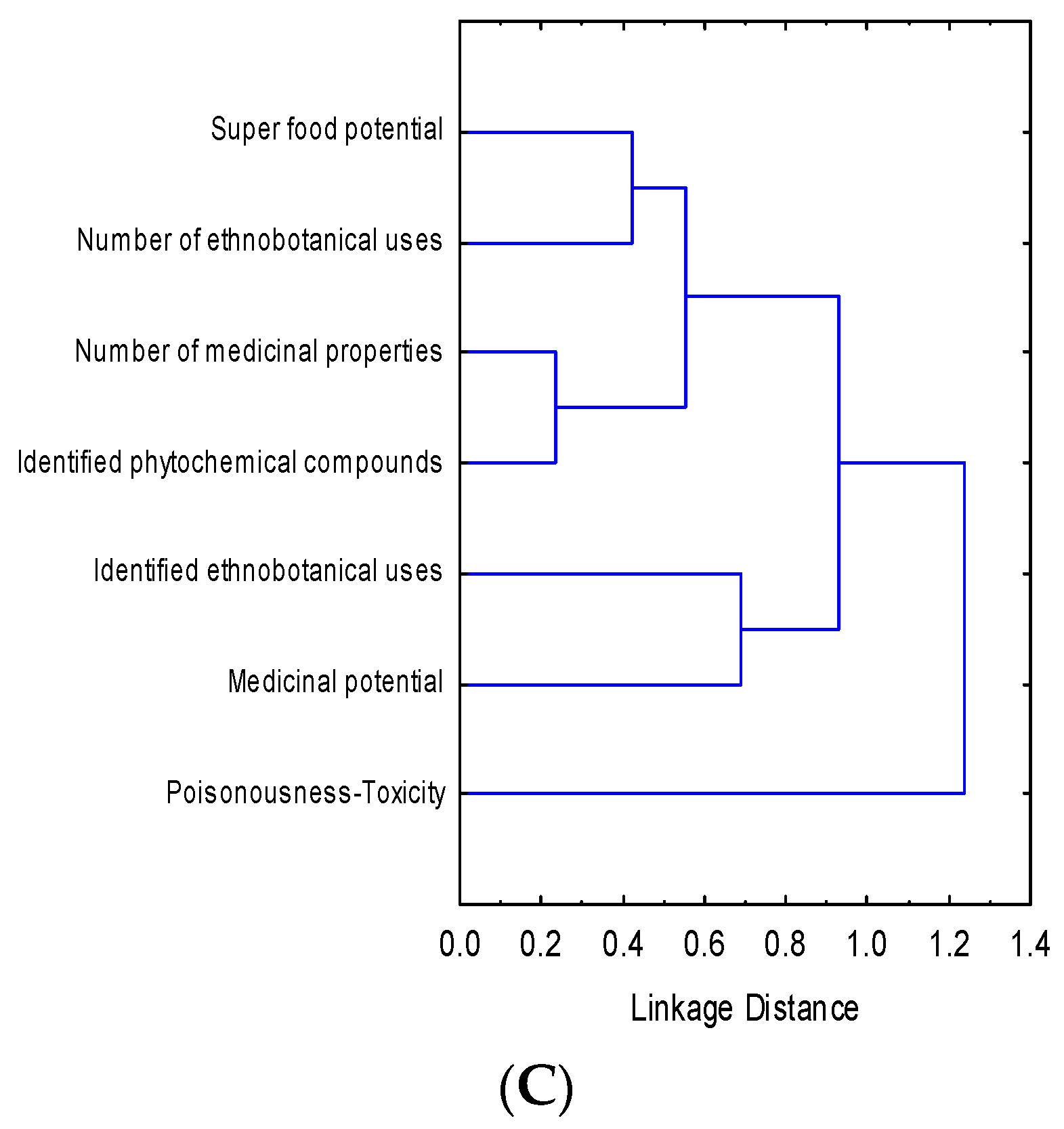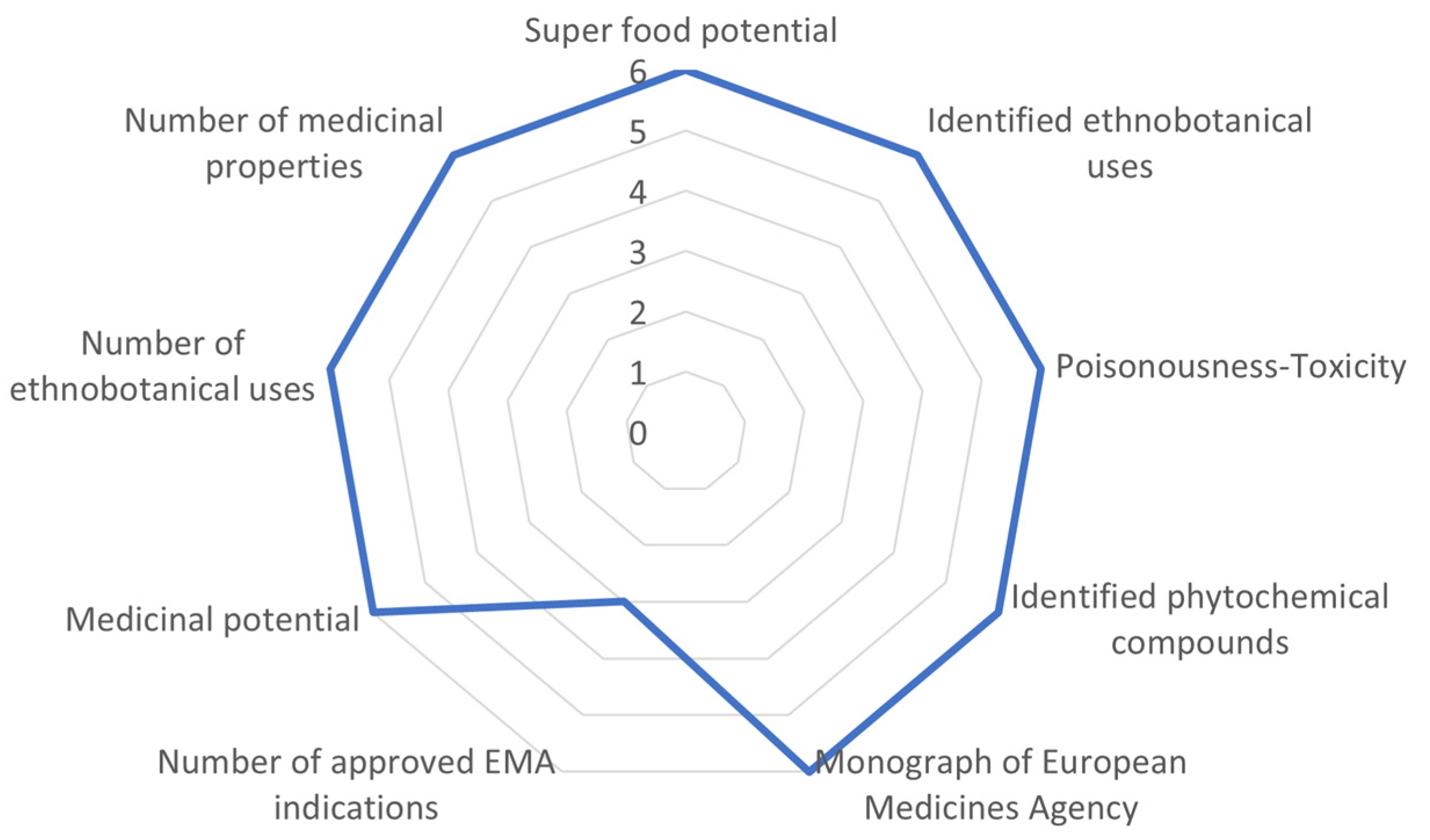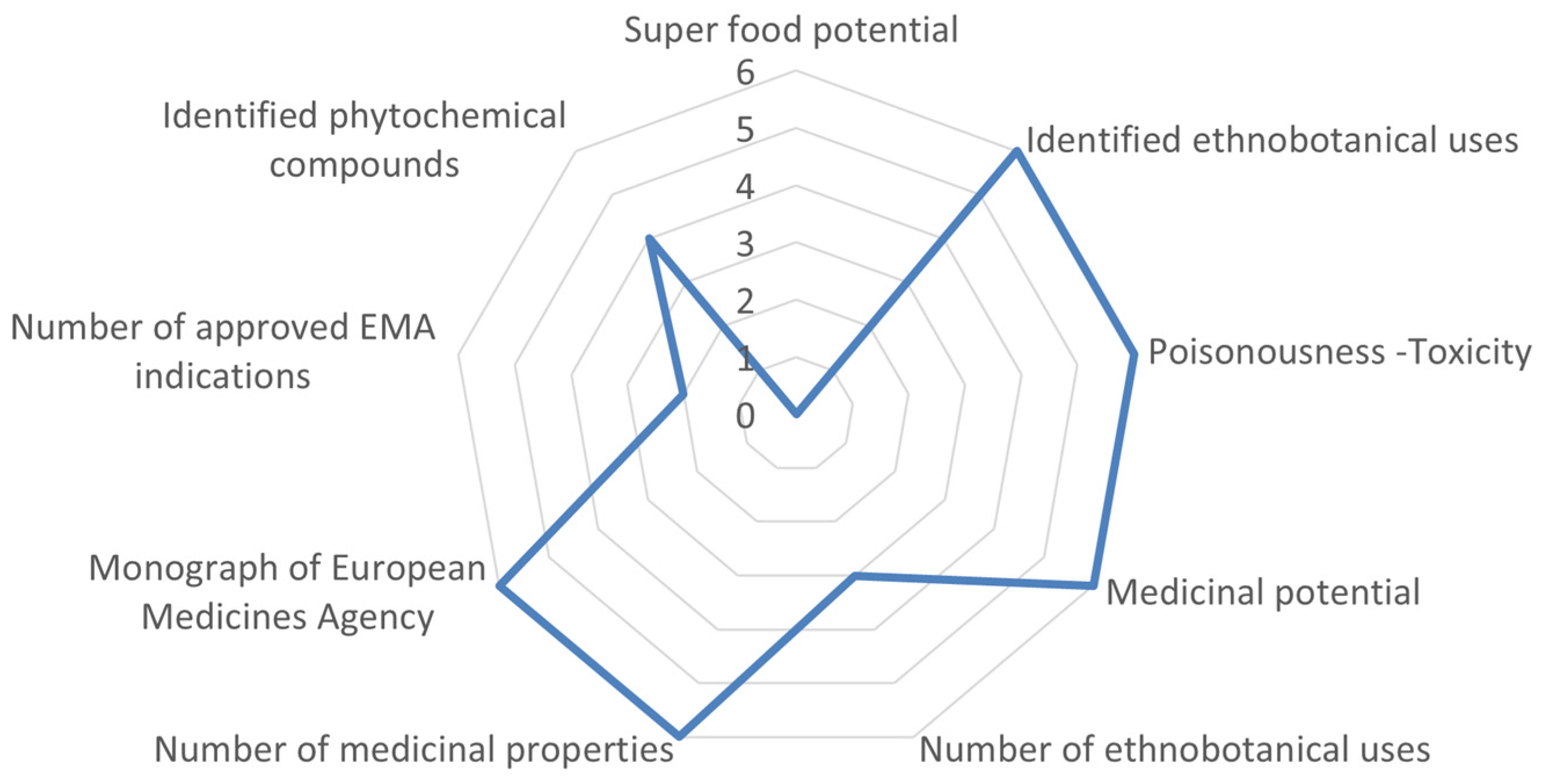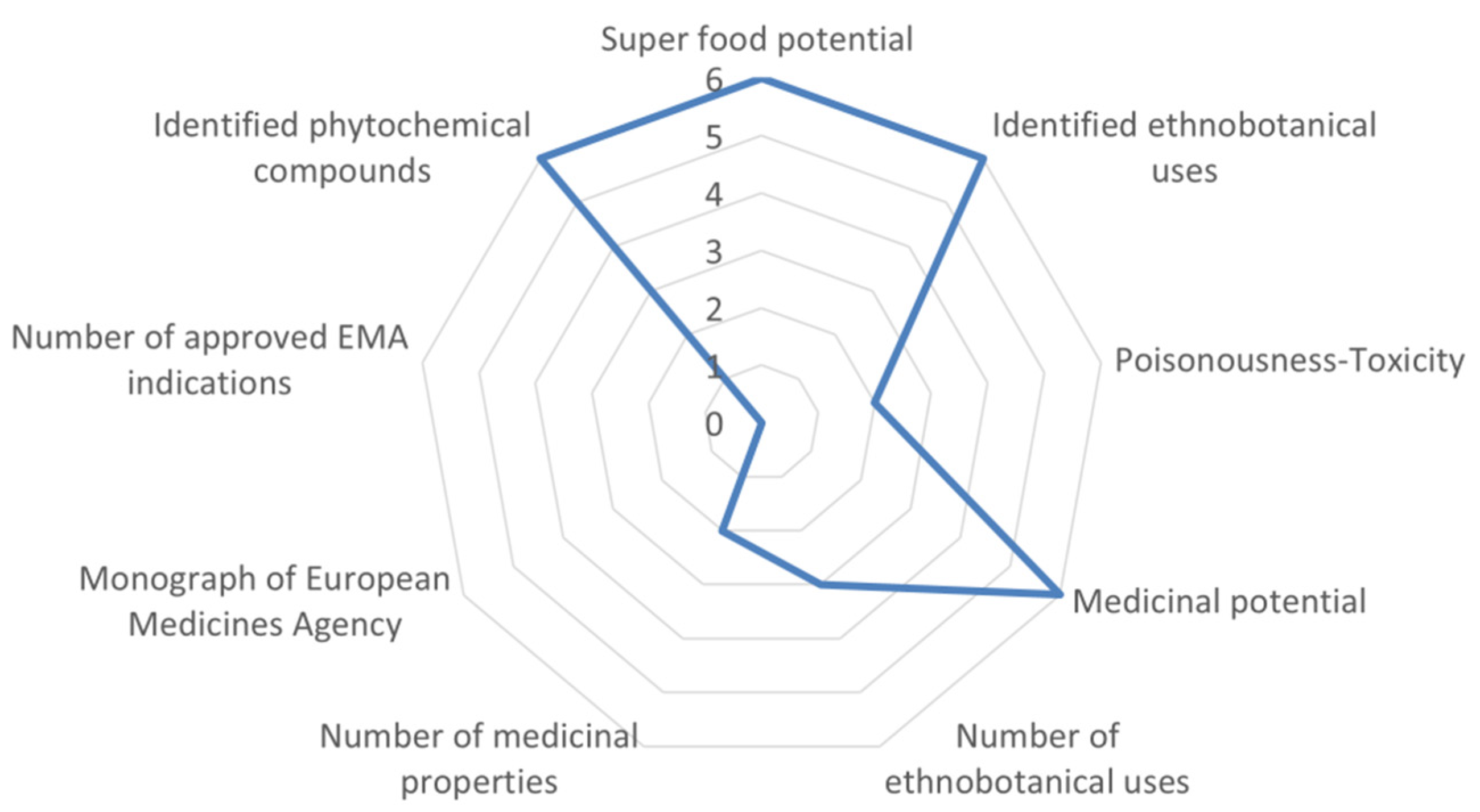Medicinal-Cosmetic Potential of the Local Endemic Plants of Crete (Greece), Northern Morocco and Tunisia: Priorities for Conservation and Sustainable Exploitation of Neglected and Underutilized Phytogenetic Resources
Abstract
:Simple Summary
Abstract
1. Introduction
2. Materials and Methods
2.1. Target Area and Focal Plants
2.2. Evaluation Levels
2.3. Statistical Analysis
3. Results
3.1. Clusterings of Medicinal-Cosmetic Attributes per Region
3.2. Overall Diversity of Local Endemic NUPs with Interesting Medicinal Potential
3.3. NUPs of Different Regions
3.3.1. Cretan NUPs
3.3.2. NUPs of the Mediterranean Coast-Rif of Morocco
3.3.3. Tunisian NUPs
3.4. Feasibility and Readiness for Sustainable Exploitation of the Top NUPs in the Medicinal-Cosmetic Sector
4. Discussion
4.1. Top-Evaluated NUPs of Crete
4.2. Top Evaluated NUPs of Mediterranean Coast-Rif of Morocco
4.3. Top-Evaluated NUPs of Tunisia
5. Conclusions
Supplementary Materials
Author Contributions
Funding
Institutional Review Board Statement
Informed Consent Statement
Data Availability Statement
Acknowledgments
Conflicts of Interest
References
- Silveira, D.; Prieto, J.M.; Freitas, M.M.; Mazzari, A.L. Herbal medicine and public healthcare: Current and future challenges. In Natural Products as Source of Molecules with Therapeutic Potential; Springer: Cham, Switzerland, 2018. [Google Scholar]
- WHO. WHO Traditional Medicine Strategy 2014–2023; World Health Organization: Hong Kong, China, 2014; Available online: https://www.who.int/health-topics/traditional-complementary-and-integrative-medicine#tab=tab_1 (accessed on 11 November 2021).
- RBG; KEW. The State of the World’s Plants Report; Royal Botanic Gardens Kew: London, UK, 2016. [Google Scholar]
- Giannenas, I.; Sidiropoulou, E.; Bonos, E.; Christaki, E.; Florou-Paneri, P. Chapter 1—The history of herbs, medicinal and aromatic plants, and their extracts: Past, current situation and future perspectives. In Feed Additives: Aromatic Plants and Herds in Animal Nutrition and Health; Florou-Paneri, P.E., Christaki, E., Giannenas, I., Eds.; Elsevier Academic Press: London, UK, 2020; pp. 1–18. [Google Scholar]
- Mahajan, M.; Kuiry, R.; Pal, P.K. Understanding the consequence of environmental stress for accumulation of secondary metabolites in medicinal and aromatic plants. J. Appl. Res. Med. Aromat. Pl. 2020, 18, 100255. [Google Scholar] [CrossRef]
- Cragg, G.M.; Newman, D.J. Natural products: A continuing source of novel drug leads. Biochim. Biophys. Acta. 2013, 1830, 3670–3695. [Google Scholar] [CrossRef] [Green Version]
- Bilal, M.; Rasheed, T.; Iqbal, H.M.N.; Hu, H.; Wang, W.; Zhang, X. Macromolecular agents with antimicrobial potentialities: A drive to combat antimicrobial resistance. Int. J. Biol. Macromol. 2017, 103, 554–574. [Google Scholar] [CrossRef]
- Krigas, N.; Tsoktouridis, G.; Anestis, I.; Khabbach, A.; Libiad, M.; Megdiche-Ksouri, W.; Ghrabi-Gammar, Z.; Lamchouri, F.; Tsiripidis, I.; Tsiafouli, M. Exploring the potential of neglected local endemic plants of three Mediterranean regions in the ornamental sector: Value chain feasibility and readiness timescale for their sustainable exploitation. Sustainability 2021, 13, 2539. [Google Scholar] [CrossRef]
- Fascetti, S.; Potenza, G.; Castronuovo, D.; Candido, V. Wild geophytes of ornamental interest in the native flora of southern Italy. Ital. J. Agron. 2014, 9, 595. [Google Scholar] [CrossRef] [Green Version]
- Maloupa, E.; Krigas, N.; Grigoriadou, K.; Lazari, D.; Tsoktouridis, G. Conservation strategies for native plant species and their sustainable exploitation: Case of the Balkan botanic garden of Kroussia, N. Greece. In Floriculture Ornamental Plant Biotechnology: Advances and Topical Issues; Teixeira da Silva, J.A., Ed.; Global Science Books: Isleworth, UK, 2008; Volume 5, pp. 37–56. [Google Scholar]
- Junqueira, A.H.; Peetz, M.S. Intellectual property rights in Brazilian floriculture: Innovations for the growth and development of the market. Ornam. Hortic. 2017, 23, 296–306. [Google Scholar] [CrossRef] [Green Version]
- Moyo, M.; Aremu, A.O.; Van Staden, J. Medicinal plants: An invaluable, dwindling resource in sub-Saharan Africa. J. Ethnopharmacol. 2015, 174, 595–606. [Google Scholar] [CrossRef]
- Grigoriadou, K.; Krigas, N.; Lazari, D.; Maloupa, E. Chapter 4—Sustainable use of mediterranean medicinal-aromatic plants. In Feed Additives: Aromatic Plants and Herds in Animal Nutrition and Health; Florou-Paneri, P.E., Christaki, E., Giannenas, I., Eds.; Elsevier Academic Press: London, UK, 2020; pp. 57–74. [Google Scholar]
- Khabbach, A.; Libiad, M.; El Haissoufi, M.; Lamchouri, F.; Bourgou, S.; Megdiche-Ksouri, W.; Ghrabi-Gammar, Z.; Menteli, V.; Vokou, D.; Tsoktouridis, G. Electronic commerce of the endemic plants of Northern Morocco (Rif region and Mediterranean coast) and Tunisia over the Internet. Bot. Sci. 2020, 100, 1–29, in press. [Google Scholar] [CrossRef]
- Salmerón-Manzano, E.; Garrido-Cardenas, J.A.; Manzano-Agugliaro, F. Worldwide research trends on medicinal plants. Int. J. Environ. Res. Public. Health. 2020, 17, 3376. [Google Scholar] [CrossRef]
- Dimopoulos, P.; Raus, T.; Bergmeier, E.; Constantinidis, T.; Iatrou, G.; Kokkini, S.; Strid, A. Tzanoudakis, D. Vascular plants of Greece: An annotated checklist. Supplement. Willdenowia 2016, 46, 301–347. [Google Scholar] [CrossRef] [Green Version]
- Fennane, M.; Ibn Tattou, M. Statistics and comments on the current inventory of the vascular flora of Morocco. Bull. Inst. Sci. Moroc. 2012, 34, 1–9. [Google Scholar]
- Dobignard, A.; Chatelain, C. Index Synonymique de la Flore d΄Afrique du Nord; Conservatoire Et Jardin Botaniques De La Ville De Genève: Genève, Switzerland, 2010. [Google Scholar]
- Menteli, V.; Krigas, N.; Avramakis, M.; Turland, N.; Vokou, D. Endemic plants of Crete in electronic trade and wildlife tourism: Current patterns and implications for conservation. J. Biol. Res. Thessalon. 2019, 26, 10. [Google Scholar] [CrossRef] [Green Version]
- Rankou, H.; Culham, A.; Jury, S.L.; Christenhusz, M.J.M. The endemic flora of Morocco. Phytotaxa 2013, 78, 1–69. [Google Scholar] [CrossRef]
- Libiad, M.; Khabbach, A.; El Haissoufi, M.; Bourgou, S.; Megdiche-Ksouri, W.; Ghrabi-Gammar, Z.; Sharrock, S.; Krigas, N. Ex-situ conservation of single-country endemic plants of Tunisia and northern Morocco (Mediterranean coast and Rif region) in seed banks and botanic gardens worldwide. Kew Bull. 2020, 75. [Google Scholar] [CrossRef]
- Libiad, M.; Khabbach, A.; El Haissoufi, M.; Anestis, I.; Lamchouri, F.; Bourgou, S.; Megdiche-Ksouri, W.; Ghrabi-Gammar, Z.; Greveniotis, V.; Tsiripidis, I.; et al. Agro-alimentary potential of the neglected and underutilized local endemic plants of Crete (Greece), Rif-Mediterranean coast of Morocco and Tunisia: Perspectives and challenges. Plants 2021, 10, 1770. [Google Scholar] [CrossRef]
- Kloukina, C.; Tomou, E.M.; Krigas, N.; Sarropoulou, V.; Madesis, P.; Maloupa, E.; Skaltsa, H. Non-polar secondary metabolites and essential oil of ex situ propagated and cultivated Sideritis syriaca L. subsp. syriaca (Lamiaceae) with consolidated identity (DNA Barcoding): Towards a potential new industrial crop. Ind. Crops Prod. 2020, 158, 112957. [Google Scholar] [CrossRef]
- Sefi, O.; Bourgou, S.; Megdiche-Ksouri, W.; Libiad, M.; Khabbach, A.; El Haissoufi, M.; Lamchouri, F.; Krigas, N.; Ghrabi-Gammar, Z. Bioactivities and phenolic composition of Limonium boitardii Maire and L. cercinense Brullo & Erben (Plumbaginaceae): Two Tunisian strict endemic plants. Int. J. Environ. Health Res. 2021, in press. [Google Scholar] [CrossRef]
- Padulosi, S.; Mal, B.; Bala Ravi, S.; Gowda, J.; Gowda, K.T.K.; Shanthakumar, G.; Yenagi, N.; Dutta, M. Food security and climate change: Role of plant genetic resources of minor millets. Ind. J. Plant Gen. Resour. 2009, 22, 1–16. [Google Scholar]
- EMA/HMPC. Final Assessment Report on Sideritis scardica Griseb., Sideritis clandestina (Bory & Chaub.) Hayek, Sideritis raeseri Boiss. & Heldr., Sideritis syriaca L., Herba (39455/2015); European Medicines Agency/Committee on Herbal Medicinal Products: London, UK, 2016. Available online: https://www.ema.europa.eu/en/documents/herbal-report/final-assessment-report-sideritis-scardica-griseb-sideritis-clandestina-bory-chaub-hayek-sideritis_en.pdf (accessed on 1 October 2021).
- Olivas, N.A.; Bejarano, C.V.; Soto, G.A.; Ortega, M.Z.; Salas, F.S.; Chávez, E.S.; Hernández Ochoa, L. Bioactive compounds and antioxidant activity of essential oils of Origanum dictamnus from Mexico. AIMS. Agric. Food. 2020, 5, 387–394. [Google Scholar] [CrossRef]
- Strid, A. Atlas of the Aegean Flora Part 1 (Text & Plates) & Part 2 (Maps), 1st ed.; Englera 33 (1 & 2); Botanic Garden and Botanical Museum: Berlin, Germany; Freie Universität: Berlin, Germany, 2016. [Google Scholar]
- Bilz, M.; Kell, S.P.; Maxted, N.; Lansdown, V.R. European Red List of Vascular Plants; Office of the European Union: Luxembourg, 2011. [Google Scholar]
- Kougioumoutzis, K.; Kokkoris, I.P.; Panitsa, M.; Strid, A.; Dimopoulos, P. Extinction risk assessment of the Greek endemic flora. Biology 2021, 10, 195. [Google Scholar] [CrossRef] [PubMed]
- Krigas, N.; Lazari, D.; Maloupa, E.; Stikoudi, M. Introducing Dittany of Crete (Origanum dictamnus L.) to gastronomy: A new culinary concept for a traditionally used medicinal plant. Int. J. Gastron. Food Sci. 2015, 2, 112–118. [Google Scholar] [CrossRef] [Green Version]
- Mitropoulou, G.; Fitsiou, E.; Stavropoulou, E.; Papavassilopoulou, E.; Vamvakias, M.; Pappa, A.; Oreopoulou, A.; Kourkoutas, Y. Composition, antimicrobial, antioxidant, and antiproliferative activity of Origanum dictamnus (dittany) essential oil. Microb. Ecol. Health. Dis. 2015, 26, 26543. [Google Scholar] [CrossRef]
- Aneva, I.; Zhelev, P.; Kozuharova, E.; Danova, K.; Nabavi, S.F.; Behzad, S. Genus Sideritis, section Empedoclia in southeastern Europe and Turkey—Studies in ethnopharmacology and recent progress of biological activities. DARU J. Pharm. Sci. 2019, 27, 407–421. [Google Scholar] [CrossRef] [PubMed]
- Stikoudi, M.; Maloupa, E.; Lazari, D.; Krigas, N. Aromagarden and Cooking for Wellness: Discovering Secrets of Mediterranean Plants, 1st ed.; i-Print: Thessaloniki, Greece, 2016. [Google Scholar]
- Abeshi, A.; Precone, V.; Beccari, T.; Dundar, M.; Falsini, B.; Bertelli, M. Pharmacologically active fractions of Sideritis spp. and their use in inherited eye diseases. Eurobiotech. J. 2017, 1, 6–10. [Google Scholar] [CrossRef] [Green Version]
- Solomou, A.; Skoufogianni, E.; Mylonas, C.; Germani, R.; Danalatos, N.G. Cultivation and utilization of "Greek mountain tea" (Sideritis spp.): Current knowledge and future challenges. Asian J. Agric. Biol. 2019, 7, 289–299. [Google Scholar]
- Menghini, L.; Massarelli, P.; Bruni, G.; Menghini, A. Preliminary evaluation on anti-inflammatory and analgesic effects of Sideritis syriaca L. herba extracts. J. Med. Food 2005, 8, 227–231. [Google Scholar] [CrossRef] [PubMed]
- Armata, M.; Gabrieli, C.; Termentzi, A.; Zervou, M.; Kokkalou, E. Constituents of Sideritis syriaca ssp. syriaca (Lamiaceae) and their antioxidant activity. Food Chem. 2008, 111, 179–186. [Google Scholar]
- Petreska Stanoeva, J.; Stefova, M.; Stefkov, G.; Kulevanova, S.; Alipieva, K.; Bankova, V.; Aneva, I.; Evstatieva, L.N. Chemotaxonomic contribution to the Sideritis species dilemma on the Balkans. Biochem. Syst. Ecol. 2015, 61, 477–487. [Google Scholar] [CrossRef]
- Marrelli, M.; Conforti, F.; Formisano, C.; Rigano, D.; Apostolides Arnold, N.; Menichini, F.; Senatore, F. Composition, antibacterial, antioxidant and antiproliferative activities of essential oils from three Origanum species growing wild in Lebanon and Greece. Nat. Prod. Res. 2016, 30, 735–739. [Google Scholar] [CrossRef]
- Gotsiou, P.; Naxakis, G.; Skoula, M. Diversity in the composition of monoterpenoids of Origanum microphyllum (Labiatae). Biochem. Sytem. Ecol. 2002, 30, 865–879. [Google Scholar] [CrossRef]
- Paschalidis, K.; Fanourakis, D.; Tsaniklidis, G.; Tzanakakis, V.A.; Bilias, F.; Samara, E.; Ipsilantis, I.; Tsoktouridis, G.; Matsi, T.; Krigas, N. Effect of conventional and integrated nutrient management fertilizers on growth and herbal quality features of the local endemic plant of Crete Origanum microphyllum (Benth.) Vogel (Lamiaceae). Agronomy 2021. under review. [Google Scholar]
- Khabbach, A.; Libiad, M.; Ennabili, A. Production and merchandising of plant resources from the province of Taza (N of Morocco). Revue AFN Maroc. 2012, 6, 64–83. [Google Scholar]
- Khabbach, A.; Libiad, M.; Ennabili, A.; Bousta, D. Medicinal and cosmetic use of plants from the province of Taza, Northern Morocco. Bol. Latinoam. Caribe. Plantas. Med. Aromát. 2012, 11, 46–60. [Google Scholar]
- Hatjimanoli, M.; Debelmas, A.M. Etude de Centaurium umbellatum Gil., identification des acides phénols. Ann. Pharm. Fr. 1977, 35, 107–111. [Google Scholar]
- Lansdown, R.V. Centaurium erythraea. The IUCN Red List of Threatened Species. 2013: E.T202950A16703434. Available online: https://www.iucnredlist.org/species/202950/16703434 (accessed on 11 November 2021).
- Tahraoui, A.; Israili, Z.H.; Lyoussi, B. Acute and sub-chronic toxicity of a lyophilised aqueous extract of Centaurium erythraea in rodents. J. Ethnopharmacol. 2010, 132, 48–55. [Google Scholar] [CrossRef]
- Balahbib, A.; El Menyiy, N.; El Omari, N.; Benali, T.; Guaouguaou, F.-E.; Salhi, N.; Naceiri Mrabti, H.; Bouyahya, A. Phytochemistry, toxicology, and pharmacological properties of Origanum elongatum. Evid. Based Complementary Altern. Med. 2021, 6658593, 1–12. [Google Scholar] [CrossRef]
- El Moussaoui, N.; Khay, E.O.; Amajoud, N.; Boujida, N.; Charfi, S.; Skali Senhaji, N.; Abrini, J. Effect of Origanum elongatum essential oil and heating on pomegranate juice quality. Int. J. Curr. Microbiol. App. Sci. 2016, 5, 1–8. [Google Scholar] [CrossRef] [Green Version]
- Douhri, B.; Idaomar, M.; Skali Senhaji, N.; Ennabili, A.; Abrini, J. Hepatoprotective effect of Origanum elongatum against carbon tetrachloride (CCl4) induced toxicity in rats. Eur. J. Med. Plants 2014, 4, 14–28. [Google Scholar] [CrossRef] [Green Version]
- Belmehdi, O.; El Harsal, A.; Benmoussi, M.; Laghmouchi, Y.; Skali Senhaji, N.; Abrini, J. Effect of light, temperature, salt stress and pH on seed germination of medicinal plant Origanum elongatum (Bonnet) Emb. & Maire. Biocat. Agric. Biotechnol. 2018, 16, 126–131. [Google Scholar] [CrossRef]
- Arista, A.; Alaoui, M.L.; Knees, S.; Gardner, M. Abies pinsapo. The IUCN Red List of Threatened Species. 2011: E. T42295A10679577. 2011. Available online: https://dx.doi.org/10.2305/IUCN.UK.2011-2.RLTS.T42295A10679577.en (accessed on 11 November 2021).
- Aloui, Z.; Messaoud, C.; Haoues, M.; Neffati, N.; Bassoumi Jamoussi, I.; Essafi-Benkhadir, K.; Boussaid, M.; Guizani, I.; Karoui, H. Asteraceae Artemisia campestris and Artemisia herba-alba essential oils trigger apoptosis and cell cycle arrest in Leishmania infantum promastigotes. Evid. Based Complement. Altern. Med. 2016, 2016, 9147096. [Google Scholar] [CrossRef] [Green Version]
- Hmamouchi, M. Les Plantes Medicinales et Aromatiques Marocaines; Imprimerie de Fedala: Mohammedia, Morocco, 1999. [Google Scholar]
- Based, B.; Oller-López, J.L.; Cuerva, J.M.; Oltra, J.E.; Mansour, A.I. Composition of the essential oil from the seeds of Abies marocana. J. Essent. Oil Res. 2006, 18, 160–161. [Google Scholar] [CrossRef]
- Yang, X.W.; Li, S.M.; Shen, Y.H.; Zhang, W.D. Phytochemical and biological studies of Abies species. Chem. Biodivers. 2008, 5, 56–81. [Google Scholar] [CrossRef]
- Wajs, A.; Urbańska, J.; Zaleśkiewicz, E.; Bonikowski, R. Composition of essential oil from seeds and cones of Abies alba. Nat. Prod. Commun. 2010, 5, 1291–1294. [Google Scholar] [CrossRef] [PubMed] [Green Version]
- Baumer, M. Le sapin du Maroc. Rev. For. Fr. 1977, 20, 343–354. [Google Scholar] [CrossRef] [Green Version]
- Boukil, A. Etude de l’évolution de la gestion de la sapinière de Talassemtane (Rif centro-occidental, Maroc). Méditerranéenne 1998, 20, 145–152. [Google Scholar]
- Hatzilazarou, S.; El Haissoufi, M.; Pipinis, E.; Kostas, S.; Libiad, M.; Khabbach, A.; Lamchouri, F.; Bourgou, S.; Ksouri-Megdiche, W.; Ghrabi-Gammar, Z.; et al. GIS-facilitated seed germination and multifaceted evaluation of the Endangered Abies marocana Trab. (Pinaceae) enabling conservation and sustainable exploitation. Plants 2021, 10, 2606. [Google Scholar] [CrossRef]
- Bahramikia, S.; Yazdanparast, R. Phytochemistry and medicinal properties of Teucrium polium L. (Lamiaceae). Phytother. Res. 2011, 26, 1581–1593. [Google Scholar] [CrossRef]
- Le Floc'h, E. Contribution à Une Etude Ethnobotanique de la Flore Tunisienne; PubIications Scientifiques Tunisiennes (Imprimerie Officielle de la République Tunisienne, Programme Flore et Végétation Tunisiennes): Tunis, Tunisia, 1983. [Google Scholar]
- Boukef, M.K. Médecine Traditionnelle et Pharmacopée: Les Plantes Dans la Médecine Traditionnelle Tunisienne; Agence de Cooperation Culturelle et Technique: Paris, France, 1986. [Google Scholar]
- Ben Haj Jilani, I.; Zouaghi, M.; Ghrabi, Z. Ethnobotanical survey of medicinal plants in northwest Tunisia. J. Med. Anthropol. 2011, 63, 78. [Google Scholar]
- Karous, O.; BenHajJilani, I.; Ghrabi-Gammar, Z. Ethnobotanical study on plant used by semi-nomad descendants’ community in Ouled Dabbeb—Southern Tunisia. Plants 2021, 10, 642. [Google Scholar] [CrossRef]
- Hachicha, S.; Barrek, S.; Skanji, T.; Ghrabi Gammar, Z.; Zarrouk, H. Chemical composition of Teucrium alopecurus essential oil from Tunisia. J. Essent. Oil Res. 2011, 19, 413–415. [Google Scholar] [CrossRef]
- Rasekh, H.R.; Khoshnood-Mansourkhani, M.J.; Kamalinejad, M. Hypolipidemic effects of Teucrium polium in rats. Fitoterapia 2001, 72, 937–939. [Google Scholar] [CrossRef]
- Baluchnejadmojarad, T.; Roghani, M.; Roghani-Dehkordi, F. Antinociceptive effect of Teucrium polium leaf extract in the diabetic rat formalin test. J. Ethnopharmacol. 2005, 97, 207–210. [Google Scholar] [CrossRef] [PubMed]
- Hachicha, S.F.; Barrek, S.; Skanji, T.; Ghrabi Gammar, Z.; Zarrouk, H. Fatty acid, tocopherol, and sterol content of three Teucrium species from Tunisia. Chem. Nat. Compd. 2009, 45, 304–308. [Google Scholar] [CrossRef]
- Bel Hadj, K.S.; Mahjoub, M.A.; Chaumont, J.P.; Michel, L.; Millet-Clerc, J.; Chraeif, I. Chemical composition and in vitro antifungal and antioxidant activity of the essential oil and methanolic extract of Teucrium sauvagei Le Houerou. Nat. Prod. Res. 2006, 20, 1089–1097. [Google Scholar] [CrossRef]
- Akrout, A.; Chemli, R.; Chreïf, I.; Hammami, M. Analysis of the essential oil of Artemisia campestris L. Flav. Fragr. J. 2001, 16, 337–339. [Google Scholar] [CrossRef]
- Memmi, A.; Sansa, G.; Rjeibi, I.; El Ayeb, M.; Srairi-Abid, N.; Bellasfer, Z.; Fekhih, A. Using of medicinal plants against scorpionic and ophidian venoms. Arch. Inst. Pasteur Tunis 2007, 84, 49–55. [Google Scholar]
- El Abed, N.; Guesmi, F.; Mejri, M.; Marzouki, M.N.; Ben Hadj Ahmed, S. Phytochemical screening and assessment of antioxidant, antibacterial and cytotoxicity activities of five Tunisian medicinal plants. Int. J. Pharma. Bio. Sci. 2014, 3, 770–789. [Google Scholar]
- Megdiche-Ksouri, W.; Trabelsi, N.; Mkadmini, K.; Bourgou, S.; Noumi, A.; Snoussi, M.; Barbria, R.; Tebourbid, O.; Ksouria, R. Artemisia campestris phenolic compounds have antioxidant and antimicrobial activity. Ind. Crops Prod. 2014, 63, 104–113. [Google Scholar] [CrossRef]
- Dib, I.; El Alaoui-Faris, F. Artemisia campestris L.: Review on taxonomical aspects, cytogeography, biological activities and bioactive compounds. Biomed. Pharmacother. 2019, 109, 1884–1906. [Google Scholar] [CrossRef] [PubMed]
- Hajaji, S.; Sifaoui, I.; López-Arencibia, A.; Reyes-Batlle, M.; Jiménez, I.A.; Bazzocchi, I.L.; Valladares, B.; Akkari, H.; Lorenzo- Morales, J.; Piñero, J.E. Leishmanicidal activity of -bisabolol from Tunisian chamomile essential oil. Parasitol. Res. 2018, 117, 2855–2867. [Google Scholar] [CrossRef]









| ATTRIBUTE | Short Description | SCORE 0 | SCORE 1 | SCORE 2 | SCORE 3 | SCORE 4 | SCORE 5 | SCORE 6 | Possible Scores |
|---|---|---|---|---|---|---|---|---|---|
| Superfood potential | Evidence-based ‘superfood’ characterization | NO | Uncertain/ Ambiguous | - | Under investigation | Possible | - | YES | 0, 1, 3, 4, 6 |
| Identified ethnobotanical uses | Documented ethnobotanical value | NO | - | - | Under investigation | - | Possible | YES | 0, 3, 5, 6 |
| Medicinal potential | Documented medicinal value | No data | - | - | Under investigation | Possible | - | YES | 0, 3, 4, 6 |
| Distinct ethnobotanical uses | Number of documented ethnobotanical uses | No data | 1 | - | 2 or 4 | - | - | 5 or more | 0, 1, 3, 6 |
| Distinct medicinal properties | Number of documented medicinal properties | No data | 1 | 2 or 3 | 4 or 5 | 6 or 7 | 8 or 9 | 10 or more | 0–6 |
| EMA Monograph status | Preparation or publication status of the herbal monograph of the European Medicines Agency (EMA) | No monograph | Assigned | Initiated | Under preparation | Published draft | Under review | Finalized | 0–6 |
| Approved indications | Number of distinct indications approved by the EMA | No approved | 1 | 2 | 3 | 4 | 5 | 6 or more | 0–6 |
| Identified phytochemical compounds | Studied categories of phytochemicals and concomitant biological activities | Not studied | - | - | Preliminary chemical profile | General chemical profile | - | Analytical chemical profile | 0, 3, 4, 6 |
| Poisonousness- Toxicity | Presence of toxic or poisonous compounds | Toxic/ poisonous | - | Possible | Suspected | Uncertain/ Ambiguous | - | Not toxic/not poisonous | 0, 2, 3, 4, 6 |
Publisher’s Note: MDPI stays neutral with regard to jurisdictional claims in published maps and institutional affiliations. |
© 2021 by the authors. Licensee MDPI, Basel, Switzerland. This article is an open access article distributed under the terms and conditions of the Creative Commons Attribution (CC BY) license (https://creativecommons.org/licenses/by/4.0/).
Share and Cite
Bourgou, S.; Ben Haj Jilani, I.; Karous, O.; Megdiche-Ksouri, W.; Ghrabi-Gammar, Z.; Libiad, M.; Khabbach, A.; El Haissoufi, M.; Lamchouri, F.; Greveniotis, V.; et al. Medicinal-Cosmetic Potential of the Local Endemic Plants of Crete (Greece), Northern Morocco and Tunisia: Priorities for Conservation and Sustainable Exploitation of Neglected and Underutilized Phytogenetic Resources. Biology 2021, 10, 1344. https://doi.org/10.3390/biology10121344
Bourgou S, Ben Haj Jilani I, Karous O, Megdiche-Ksouri W, Ghrabi-Gammar Z, Libiad M, Khabbach A, El Haissoufi M, Lamchouri F, Greveniotis V, et al. Medicinal-Cosmetic Potential of the Local Endemic Plants of Crete (Greece), Northern Morocco and Tunisia: Priorities for Conservation and Sustainable Exploitation of Neglected and Underutilized Phytogenetic Resources. Biology. 2021; 10(12):1344. https://doi.org/10.3390/biology10121344
Chicago/Turabian StyleBourgou, Soumaya, Imtinen Ben Haj Jilani, Olfa Karous, Wided Megdiche-Ksouri, Zeineb Ghrabi-Gammar, Mohamed Libiad, Abdelmajid Khabbach, Mohamed El Haissoufi, Fatima Lamchouri, Vasileios Greveniotis, and et al. 2021. "Medicinal-Cosmetic Potential of the Local Endemic Plants of Crete (Greece), Northern Morocco and Tunisia: Priorities for Conservation and Sustainable Exploitation of Neglected and Underutilized Phytogenetic Resources" Biology 10, no. 12: 1344. https://doi.org/10.3390/biology10121344
APA StyleBourgou, S., Ben Haj Jilani, I., Karous, O., Megdiche-Ksouri, W., Ghrabi-Gammar, Z., Libiad, M., Khabbach, A., El Haissoufi, M., Lamchouri, F., Greveniotis, V., Avramakis, M., Hatzilazarou, S., Anestis, I., Tsoktouridis, G., & Krigas, N. (2021). Medicinal-Cosmetic Potential of the Local Endemic Plants of Crete (Greece), Northern Morocco and Tunisia: Priorities for Conservation and Sustainable Exploitation of Neglected and Underutilized Phytogenetic Resources. Biology, 10(12), 1344. https://doi.org/10.3390/biology10121344










